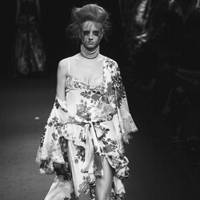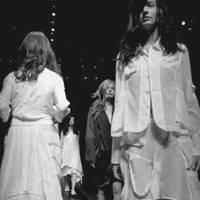The Japanese fashion business is abuzz with the news that the six-week-long Tokyo Collections event that has forever been largely ignored by the international media is to be compressed into a government-backed, 10-day industry showcase staged in the grounds of Meiji Shrine in Tokyo's supertrendy Harajuku district.
Will journalists and buyers from overseas finally come and see what designers closest to the world's most voracious consumers of brand clothing are coming up with?
Established in 1985, the Tokyo Collections and its organizing body, the Council of Fashion Designers, find themselves defunct on the eve of their symbolic 20th anniversary. Many industry figures are glad to see the back of the unwieldy event.
"The Tokyo Collections has been failing Japanese designers," says Makiko Awata, editor at fashion business weekly WWD. "Overseas buyers and journalists don't come here, and that's the main reason why many of them move their shows overseas when they become successful."
The prime goal in establishing the new event -- christened Japan Fashion Week -- is to generate attention from outside Japan. But it is a group of textile manufacturers, not designers, who have managed to persuade the Economy, Trade and Industry Ministry to put in 300 million yen toward the catwalk extravaganza. They hope that the resulting media coverage will boost exports, which have tumbled in the face of stiff competition from cheaper Chinese manufacturers.
Japan Fashion Week will be held from Oct. 31, some three weeks after the Paris Collections -- which is traditionally the season's concluding event -- has come to an end.
However, whether the world's fashion journalists will actually make the trip over to notoriously expensive and alien Tokyo remains very much in question.
"I'd be highly doubtful as to whether the 'right' journalists will go all the way to Tokyo after a gruelling seven weeks on the road." says London-based style writer Robb Young. "The top people have all already been [to Tokyo] . . . so I doubt there'll be any heavyweights in attendance."
Pulling power
For their part, though, Japanese designers are more excited about the prospect of welcoming visiting buyers than attracting media coverage, and although a call-around revealed that most were positive about the new compressed schedule, many expressed skepticism as to pulling power of the event.
"Buyers are unlikely to come, and even if they do, I doubt they'll place orders," said Hokuto Katsui of the leading Tokyo-based Mint Designs label. "Still, we'll do our utmost to cooperate and make it a success."
For many small brands, however, cooperating fully is beyond their means. The event's organizing body will charge designers 500,000 yen for use of the smaller of two marquees to be erected in Meiji Shrine Outer Gardens, with the larger one costing a cool 1 million yen.
At present, most Tokyo Collections participants have been spending a fraction of that on their catwalk venue, but the more successful labels were undeterred by potentially high costs. Positive noises were also emanating from the stable of much-hyped brand Dress Camp, and Issey Miyake disciple Sunao Kuwahara. Rising star Soichiro Ito of Soe was also upbeat about the event. "I will almost certainly be taking part," he said. "It's a very exciting development for Tokyo fashion."
Although there does seem to be a deal of excitement about Japan Fashion Week within industry circles, many are also nervous about whether it can be pulled off. With the final go-ahead announced only last month, there is little time for planning and preparation, or for crucial negotiations with corporate sponsors.
Fashion News editor Risa Okamura was among those to voice concern. "In my opinion, it will be difficult to build a new system in one go," she said.
Certainly, a hastily organized launch might jeopardize the long-term success of the event -- but the wheels are already in motion, for better or worse.
"The domestic fashion industry has marshaled all its resources for this event," declared Shigeki Okamura, former top executive at Tokyo design house Junko Shimada and now the man spearheading the charge to put Tokyo firmly on the fashion map.
"There's no turning back from here on now," he added defiantly.
Japan's fashion fraternity is hoping and praying they are headed in the right direction.





















With your current subscription plan you can comment on stories. However, before writing your first comment, please create a display name in the Profile section of your subscriber account page.